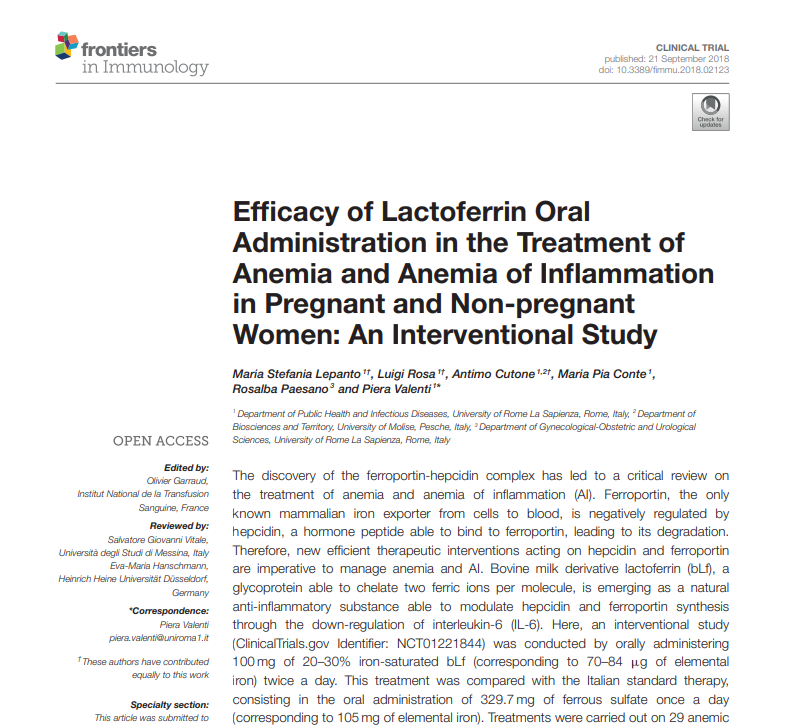Efficacy of Lactoferrin Oral Administration in the Treatment of Anemia and Anemia of Inflammation in Pregnant and Non-pregnant Women: An Interventional Study
Maria Stefania Lepanto 1†, Luigi Rosa 1†, Antimo Cutone 1,2†, Maria Pia Conte 1,Rosalba Paesano 3 and Piera Valenti 1
The discovery of the ferroportin-hepcidin complex has led to a critical review on the treatment of anemia and anemia of inflammation (AI). Ferroportin, the only known mammalian iron exporter from cells to blood, is negatively regulated by hepcidin, a hormone peptide able to bind to ferroportin, leading to its degradation. Therefore, new efficient therapeutic interventions acting on hepcidin and ferroportin are imperative to manage anemia and AI. Bovine milk derivative lactoferrin (bLf), a glycoprotein able to chelate two ferric ions per molecule, is emerging as a natural anti-inflammatory substance able to modulate hepcidin and ferroportin synthesis through the down-regulation of interleukin-6 (IL-6). Here, an interventional study (ClinicalTrials.gov Identifier: NCT01221844) was conducted by orally administering 100 mg of 20–30% iron-saturated bLf (corresponding to 70–84 µg of elemental iron) twice a day. This treatment was compared with the Italian standard therapy, consisting in the oral administration of 329.7 mg of ferrous sulfate once a day (corresponding to 105 mg of elemental iron). Treatments were carried out on 29 anemic women with minor β-thalassemia (20 pregnant and 9 non-pregnant), 149 women with hereditary thrombophilia (HT) (70 pregnant and 79 non-pregnant) affected by AI and 20 anemic pregnant women suffering from various pathologies. In anemic pregnant and non-pregnant women with minor β-thalassemia, presenting undetectable hepcidin levels, differently from ferrous sulfate management, bLf decreased IL-6 (from 25 ± 8 to 6 ± 3 pg/ml) and increased total serum iron (TSI) (from 54 ± 17 to 80 ± 9 µg/dl). BLf was also more efficient than ferrous sulfate in AI treatment in HT pregnant and non-pregnant women by decreasing both serum IL-6 (from 89 ± 8 to 58 ± 6 pg/ml) and hepcidin (from 115 ± 23 to 65 ± 10 ng/ml), thus increasing hematological parameters, such as the number of red blood cells (RBCs), the concentration of hemoglobin, TSI and serum ferritin. BLf was also efficient in treating anemia in other pathological pregnancies. Taken together all the results, bLf, showing Lepanto et al. Lactoferrin Efficacy in Treating Anemia a greater benefit and efficacy than the standard ferrous sulfate management, can be considered as a promising compound in treating anemia and AI through its ability to down-regulate IL-6, thus restoring ferroportin-mediated iron export from cells to blood in a hepcidin-dependent or independent way
Читать полностью
